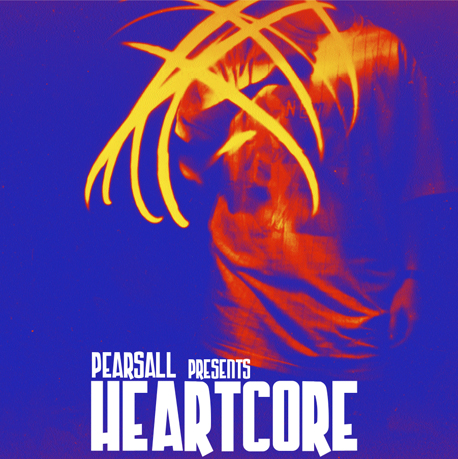Pearsall presents Heartcore
right-click on the title and save as to download
Mixed in Edinburgh, August 2010
(57:20, 104 MB, V0 VBR MP3)
Zip pack (cut into individual tracks)
Big cover
Cue file
Style: Classic, fast European hardtrance from the mid-90’s
Direct link to the mix:
http://sonicrampage.org/mixes/heart/Pearsall-Heartcore.mp3
Tracklisting:
01. Phrenetic System – Wayfarer (Mayday Mix) (Bonzai)
02. DJ Jamo & Jack Knives – Seastar II (Remix) (Dance Ecstasy 2001)
03. Gary D. – Kinetic Pressure (Bonzai)
04. Code 28 – Feel My Desire (Cocooma Remix) (United Ravers)
05. Nexus 6 – Tres Chic (Noom)
06. Slashing Funkids – Imagination (EDM)
07. Code 19 – Es Geht Los (Hard Trance Mix) (United Ravers)
08. Paranoia X – Party Programm (ZYX)
09. Xavi Escolano – D.A.F.Y.K. (DJ’s At Work)
10. Nostrum – Dating Rob (Time Unlimited)
11. Lunatic Asylum – People Want Paradise (Dance Ecstasy 2001)
12. Cortex Thrill – Innerspace (Bonzai)
13. Nitre – Crowd Control (Cenobite)
14. DJ Gollum – The Energy (Trance Mix) (UK44)
15. Mega ‘Lo Mania – Time (No Respect)
16. Fanatic Cracks – I Try To Believe (Fire)
17. DJ Jo – Space Harmony (Gary D. Remix) (No Respect)
18. DJ Tibby – Energy (Cocooma Remix) (Fog Area)
19. Meteor Seven – Circular Riot (Fire)
20. Apple Juice – Raving Together (Signal)
21. Abet – The Sweetest Song (Remix) (Tunnel)
22. Ultimate – Hypnotic Feeling (Spaceflower)
Enjoy this mix? Click here to leave a comment
Heartcore by Pearsall on Mixcloud
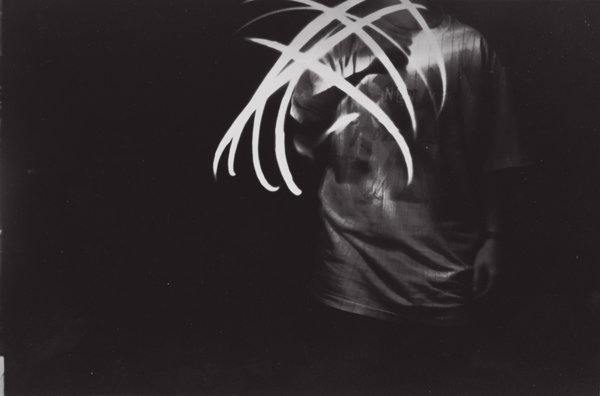
Do you know that feeling, where you love something so intensely that you are not sure that you can do it justice?
This has been my situation with the music on this mix.
It is hard to put into words what this music means to me, how important these greatest tunes from the golden era of mid-90’s European hardtrance actually are. This strength of feeling is probably why I have ummed and ahhed over doing this mix for such a long time now – I have always wanted to do it right, and I wasn’t sure quite how to do this music justice.
This isn’t to say that these tunes are what I listen to the most – not at all (in case you are wondering, I listen to dubstep more than any other type of music). In fact, I don’t listen to this kind of music that often these days, really.
So what do I mean when I say that it is so precious to me?
How important can it really be if I don’t listen to it that often?
Well, it clearly has a pretty special place in my heart, because every time I get drunk I end up staggering to the decks, putting the headphones on, and pulling these tunes out for a good bounce around the spare room!
More seriously, I guess a lot of this passion comes from nostalgia. It’s hard for me to separate this music from my memories, since I first got into this music back in the mid-90’s, when I was only a teenager.
At the time, I was really into drum n’ bass (and I’ve written elsewhere about my teenage love for that music), but my friends were really into psy-trance (or Goa trance as it was then known), so trance was a big part of my weekend soundtrack. Anyways, I used to buy dnb mixtapes from a guy who had a little stall on Camden High Street, but one day, on a whim, I picked up an M-Zone tape from him. I’ve got a good memory, but even so, this was a long time ago, so I don’t really remember why – maybe it came from reading a review of an M-Zone set or something, maybe I was curious, or maybe it was even something prosaic like getting it as part of a three tapes for a tenner deal. In any case, despite not being that into trance, I decided to get this tape.
What. A. Revelation.
I had never heard trance like it.
It was faster and bouncier than the Goa trance my friends listened to, and it had better melodies. It sounded like it had been beamed straight from the future.
I hammered that tape to the point where it sounded like it had been recorded underwater, and I did the same with all of the subsequent M-Zone tapes that I picked up from tapepacks put out by the likes of Dreamscape, Helter Skelter, and Slammin Vinyl.
Looking back, sometimes the mixing could leave a little (or even occasionally a lot) to be desired, but my God THE TUNES HE PLAYED. Words don’t even begin to describe them. Monster, then monster, then monster, relentlessly. Above all, what set M-Zone apart from other dj’s was his genius for programming his mixes. He had an uncanny ability to only play the best bits of tunes and skip the junk.
For example, take this tune, ‘Airwalk’ by Genlog. Until I bought this tune for myself, I had no idea that the tune changed so radically for the worse after the first two minutes, since that was the only section that M-Zone ever played (or at least that I ever heard him play). A bouncing bassline, flying melodies, and twinkling pianos – the first two minutes are truly beautiful stuff. And then, frankly, it goes a bit shabby, so kudos to M-Zone for always getting out of the tune before it went pear-shaped.
If there are any teens reading this page, you will probably be baffled to find that not much more than ten years ago it was difficult to find out much about music through the web, especially an underground scene like this kind of hardtrance was in the UK. Times were different! I had no idea what these tunes were called, who made them, what labels they came out on, or where I could pick them up (and I really wish I had known at the time, given the incredible prices some of these tunes now fetch second-hand!). Even worse, I had no real idea in those dark, pre-Google days where I could go to actually find that information.
And it wasn’t as if I had the chance to dance to M-Zone either. The trance nights I went to in London with my friends (Escape From Samsara, Pendragon, Techtonic, Trancentral, etc) never played this stuff, or at least not much, and so my only link to it was through tapes from big hardcore raves. It was tough enough going out to clubs back then – we had one friend with a mother who was tolerant enough to cover for us going out raving, but even she would have balked at sanctioning us to travel half-way across England to hit a big rave at somewhere like Shepton Mallet or the Sanctuary in Milton Keynes!
So my nostalgia for this music is more private than my nostalgia for some other forms of 90’s dance music – it’s not linked to nostalgia for the scrum over new white labels in the basement of Blackmarket Records, or wild-eyed stomping to pounding acid in East London warehouses, but to walking to and from school, Walkman on, cigarette at my lips, pulsating melodies filling my ears.
In the years since then I have come to learn the names of all those thrilling tunes, as well as who made them, and what labels they appeared on. It’s been a painstaking process, and I am still discovering exciting tunes from that era, but by know I think that I have a pretty good sense of mid-90’s European hardtrance, at least musically. What I still don’t know, however, is much of anything about the scene that birthed it – I know vaguely that a lot of these tunes were popular at northern English raves like Distruxshon and North, but for the most part this music exists in a void for me. I can put, say, acid techno or jungle or grime or a bunch of other electronic music sub-genres into a cultural context, but with this stuff, I have absolutely no idea about what the hardtrance scene in Europe was like in the mid-90’s when all of these amazing tunes were being made.
I mean, I know next to nothing about the key clubs and raves (beyond Mayday, the Tunnel in Hamburg, and, of course the original Love Parade in Berlin), I don’t know anything about what clothes people wore, what magazines or radio shows supported the scene, who the main dj’s were, what kind of people listened to the music, how the scene developed, or why the music slowed down so radically in the late 90’s. Basically, I have no knowledge about the context of hardtrance in that era in Germany, Holland, and Belgium, and I’ve never found any reliable information about it.
In fact, as a scene it seems to have slipped through the cracks of social history, because despite being clearly massive at one point, there seems to be hardly any information available on it in English. As an example, if you google, say, “germany hardtrance rave scene 90’s”, the information you get back is worthless; nothing to help fill in the blanks. I’m not sure why this is – maybe because it’s not considered a ‘cool’ music, and therefore worthy of subcultural scrutiny? Maybe it’s just that it was so minor in the UK that no one has ever paid much attention to it, and there could be a lot of information available in German about this scene that’s never been translated into English. I just don’t know! In any case, if you know of anywhere I could find out more, I’d really appreciate it if you could leave some info in the comments.
As I said in the beginning of this post, I’ve put off doing this mix for years because I wanted to make sure I would get it right, that I could do this music justice. A big part of that process has been building the collection until I felt the moment was right to plunge and get it done … of course, that moment would probably have been put off indefinitely if Heartcore hadn’t won the the poll I conducted recently to decide my new mix. Sometimes it’s good for other people to give you the push you need to actually get up and do something!
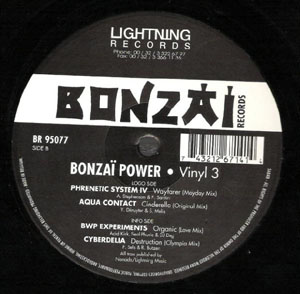
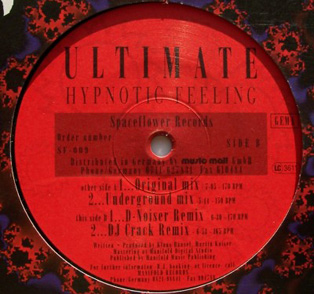
So, once it was clear that this would be the next mix to do, I started to think about what would go on it, and how I would construct it. Clearly, there was no need to mess around – a mix like this would have to get straight to the point, so I decided to start with the Mayday mix of ‘Wayfarer’, with its thundering kickdrum and firing synths. At the other end, I wanted to finish with the hyperspeed euphoria of ‘Hypnotic Feeling’ by Ultimate, so all that remained to do was plot a course between these two tracks that would maintain energy and excitement over the whole mix whilst still varying the vibe over the course of the mix.
Easier said than done!
I’ve written at length elsewhere about how I program mixes, but, when it came to doing this mix I decided that I wouldn’t mess with the basic formula of working from slower to faster (in this case from about 165 bpm to just shy of 180 bpm), whilst still trying to take in several different feelings along the way, from fluffy melodies to dark twisted acid to bouncing rave mayhem to full-power euphoric madness. To get the mix of tunes right, I began by pulling out a stack of about 60 tunes, which I then slowly whittled down until I had a selection of tunes that I felt would create the right sonic narrative between ‘Wayfare’ and ‘Hypnotic Feeling’.
The next step was to figure out how to actually mix them together. This music can be quite tricky to mix sometimes, due to the strange ways that the producers would structure some of these tracks (in this sense, it’s much easier to mix dubstep, where the tracks are structured in very similar ways). Anyways, this tendency to add in weird little fills has the annoying effect of throwing off the sequencing of the mix, so I spent a fair amount of time experimenting with different tracks, seeing which ones worked well together, as well as working out the optimal way to mix between them – where to release the record, where to start bringing it in, where to switch the basslines, and then where to take the old record out of the mix. This process helps to reveal which tunes don’t work together (or even can’t really be mixed very easily at all), as well as which mixes require special care.

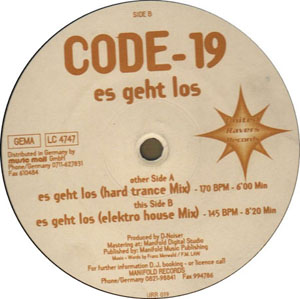
To take an example, let’s look at the mix I did from ‘Imagination’ to ‘Es Geht Los’. This is a very good example, because I had to practice this mix a number of times in order to get it right. The first difficulty I had with this particular mix is that ‘Es Geht Los’ has a long beatless intro. This is tricky for me because my particular style of mixing makes it difficult to mix long beatless sections accurately.
One of the things that I have taught myself to do when I am mixing is ‘ghosting’ the pitch control, i.e. adjusting the speed of the record after I drop it into the mix. Most dj’s do their fine-tuning of the pitch before they actually drop it in, but at that stage I am usually more focused on making sure the levels of the new record match the old one and getting the placement of the mix right than I am on making sure that the pitch control is in the absolutely correct place. I have a good memory so I can always remember roughly how fast a record needs to be playing, but once I drop it I then tend to make all of the necessary adjustments as I bring it in. Mixing this way allows me to get new tracks quickly into the mix, but the downside is that it requires a lot of supervision to make sure the tracks don’t drift out of time.
The issue with using this method of mixing to mix long beatless intros is that it is much harder for me to gauge the extent to which the mix is drifting out of time than when I am mixing actual beats (where it’s quite easy to tell that the tracks are slipping out of sync), so I tend to do fewer micro-adjustments to the pitch control. Sometimes this doesn’t matter, but in some cases this lack of fine-tuning can lead to a horrible mess when the beat finally kicks in. So, to avoid this risk, I usually skip a beatless intro and go straight to where the beat kicks in, which was my approach to mixing into ‘Es Geht Los’. I initially tried dropping the first beat right at the point where ‘Imagination’ kicked back in after the snare roll, yet for some reason it always sounded weird and out of sync – the beats were in time, yet as new elements of each track appeared they weren’t dropping in time with each other.
So, scratching my head, I tried dropping ‘Es Geht Los’ on the first new beat of ‘Imagination’ and then speeding it up with my finger to re-sync it.
That still didn’t work.
Eventually I realized that the first beat of ‘Es Geht Los’ was a false start, and that actually I had to mix it from the second beat … as I said, these old German producers had a habit of structuring their tracks in weird ways! Having figured that one out, the mix still didn’t quite work like I wanted, since the main melody of ‘Es Geht Los’ was coming in too soon for my taste, so I decided that the best way to mix into it would be to drop it a bit later (on the second beat, of course), right where the hi-hat on ‘Imagination’ comes back in. As you can hear from the actual mix itself, this works nicely because the new elements of each track are introduced in harmony, and the new melody from ‘Es Geht Los’ drops into the mix at the right moment for me to switch the basslines over.
As you can see, sometimes these things require a lot of thought!
To finish off this long (and somewhat rambling) essay, I’d just like to thank everyone who voted for this mix, since it’s been great fun making it, and I’ve loved listening back to the end result. Without being too gushy, what’s been particularly good about this project has been the fact that going through the tracks, and then writing this essay, has allowed me a chance to really look back at my teenage years. This has been a very timely project, since I was just down in London this weekend clearing out my old bedroom as, after 17 years there, my parents have sold the family home. Combined with the fact that I am turning 30 soon, it’s clearly the end of one era in my life, so it’s been good to have the opportunity to go back to a much earlier part of my life.
Of course, the fact that this music totally fucking rocks helps too!
